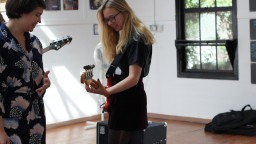M3 – The music leader plans sessions that enable young people to make progress and nurtures their understanding of what it means to be a musician.

How do we engage hard to reach young people in our relatively short music sessions? The most important thing we can do to engage these individuals is to ensure that (at least at the beginning) they experience some ‘quick wins’. We try to simplify our craft down to the bare minimum, use our skills to make even the simplest of things sound as good as possible. Whether this is using alternate tunings on a guitar, applying a good effects chain to a vocal mic or whatever else suits the art form; a little bit of planning and thought ahead of time can do wonders in the session.
I worked with one young musician who loved the idea of being a rapper, but got frustrated by how slow the process of putting a track together was. How could I get him to create something quickly? I decided to use some technology that is aimed at inexperienced musicians.
Before the session, I set up two Roli Blocks. They enable the user to play in rhythms, bass lines and melodies with a range of great sounds before layering them up and creating arrangements - all of this with one finger! Before the participant came into the room, I set up the Blocks with a drum sound I thought he’d like. They're designed so that they are very difficult not to touch and play with. They look very inviting, covered in cool flashing lights, and so as soon as my participant walked through the door he said, “Wow, what’s that!?” and then, as soon as he touched it, even before he knew what he was doing, he was creating a drum pattern that sounded good and that he could imagine rapping over.
Now that he was hooked, I went into a bit more detail with him about how he could use the technology to add extra sounds. Over the next few minutes we built up several loops of drums and synth sounds that he was really proud of. I kept it simple, only using four different sounds. Sometimes, as musicians, we can go into too much detail with our explanations, tips, techniques and productions, and risk disengaging the participant. Once this process was over, the participant got on the microphone with some lyrics. I handed him another one of the Blocks that was set up to trigger the loops he’d just made, turning them on and off. He burst into a performance, both recording his rap and building up the structure and arrangement of the track in real time to suit his lyrics. After about an hour he had created a great sounding track and recorded his own vocals over the top.
Since that session, he has loved making music in our time together and I’ve been able to go into much more detail about certain processes.
Taken from Quench Arts’ music leader James Stanley
Drake Music: Providing appropriate progression routes for young Disabled musicians requires a flexible, patient approach to teaching and learning and the confidence to make judgements around assessment.
Example: A new Music Co-ordinator in a school wants to offer an accredited music course for her KS4 class. She researches the options and chooses the best fit, both for herself and the access requirements of her pupils, and then attends some relevant training on assessment.
